I posted last week about my research experience in Alaska. Before I discuss the research project, I want to describe the techniques I used to capture the birds.
The larger birds – Common & Thick-billed Murre and Red & Black-legged Kittiwakes -were captured with a simple noose attached to a long pole. These seabirds nest on cliffs away from the ground. Why do you think they do that?

Black-legged kittiwakes build nests on cliffs; Note the bird on the upper right has a black smudge on its face. That's so we can keep track of it. We also have leg bands on the birds which you can see on two of the birds in this photo.
In order to capture the birds I used a long noose pole. I would dangle the noose over the bird’s head and then pull! This didn’t hurt the bird, but I’m sure it was quite a shock! Why was I able to do this without breaking the bird’s neck?

I remember this Red-legged Kittiwake capture! It was tough! Look at the end of the pole and you can just barely make out the bird I was attempting to capture.

Look at my pretty red feet!
Common & Thick-billed Murres also nest on cliffs, but they tend to nest up higher than kittiwakes so we had to noose them from above.
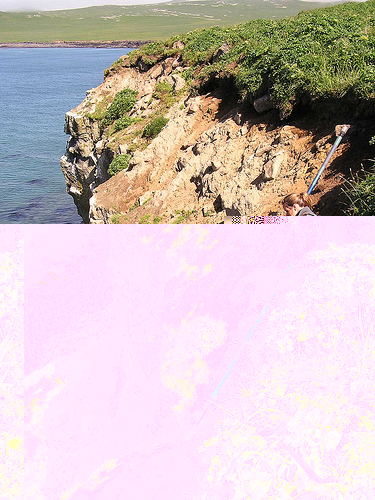
My research partner Ali bravely sits on the edge of a cliff to capture a Common Murre.

Common Murres nest on cliffs, but note the absence of a nest. Murres just lay their eggs directly on the cliff. What would be the advantage and disadvantage of that?
The noose method only works on large birds. How did I catch the medium-sized Crested and Parakeet Auklet? I used something called a mist net. Mist nets are nylon mesh strung between two poles. When set up they are very hard to see! Can you see the mist net in this picture?
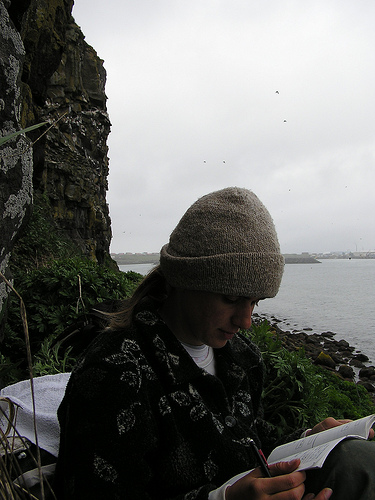
I promise there's a mist net strung up behind me. Can you see it? I can't!
Because it’s nearly invisible, my partner and I would set up the mist net right in front of an area where Parakeet & Crested Auklets were nesting (like the Murres, they also nest on cliffs). When the adults would leave the nest to fly out to sea, they would swoop down into our waiting net.

Removing a Crested Auklet from the mist net. Now, can you see the net?
I thought the mist net was the most difficult of all the techniques as the birds would sometimes get quite tangled and it was hard to get them out. It was really stressful because we had to get the birds out within two minutes to take a blood sample right away (more on that later).
The smallest bird, the Least Auklet, doesn’t nest on cliffs. It nests in rock crevices! The Least Auklet is only the size of a sparrow, making it one of the smallest seabirds. Why does it nest in rocks?
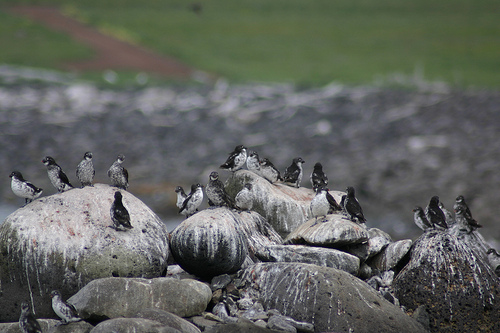
Least Auklets sitting on rocks. They nest in the crevices below.
It was really fun capturing these birds. We made noose mats – basically, mesh that had tiny little loops tied into the mesh. When the birds would step on the mat and walk around, their feet would get stuck in the loop, and when they tried to fly away – caught!! It was fun because sometimes you’d catch two or three birds at a time.
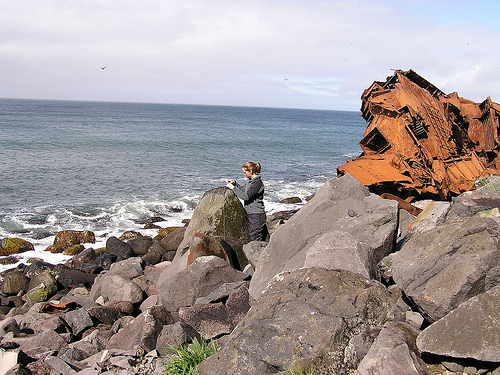
My research partner, Ali, sets up a noose mat on a popular Least Auklet hangout. Note the shipwreck!
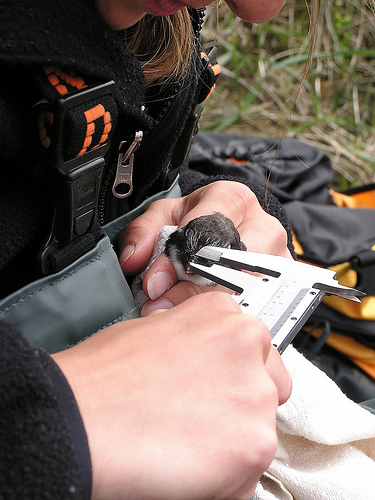
Measuring a Least Auklet's beak.
So those are the techniques I used to capture the seabirds. Did you think it looked like fun? Would you like an experience like this one? A couple of years ago I took some students on a research expedition to study seabirds in Alaska through the organization Earthwatch. They have some great research trips for teenagers. Most of them are quite expensive, but they do have a fellowship program (unfortunately, the deadline was December – next year!). Let me know if you’re interested in an Earthwatch trip and I can give you tips on which ones are really good (I still know people who work there).
I will end with a great video of the island I was on – St Paul Island, Alaska. Brings back such great memories! Truly one of the most amazing experiences of my life!







